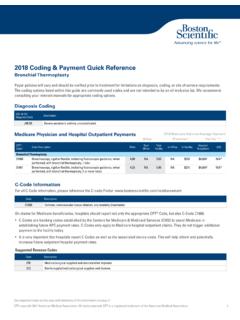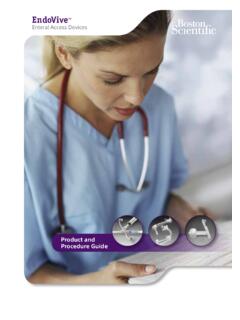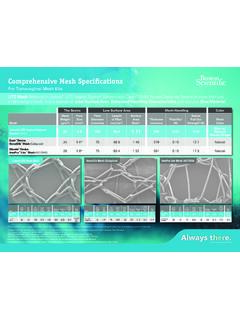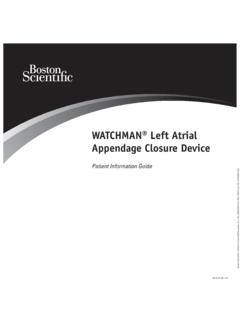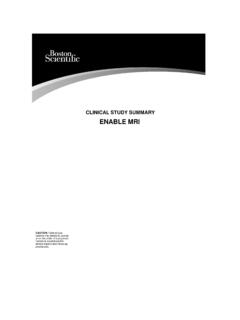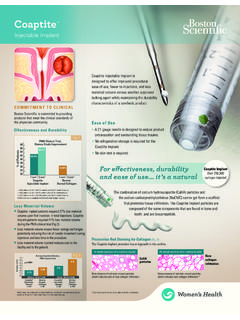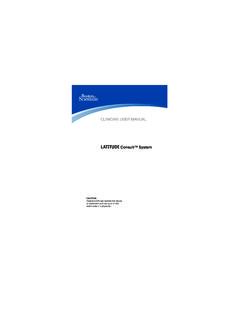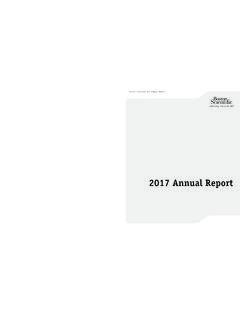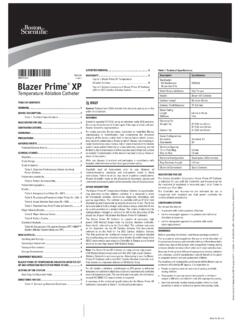Transcription of PROPONENT MRI Pacing System - Boston Scientific
1 Mechanical Specifi cations Size (cm) Connector Type Model Type (W x H x D) Mass (g) Volume (cc) (RA RV LV) L209 (non-MRI model) VDDR x x RA: IS1 RV: IS1 L210 SR x x RA/RV: IS1 L211 DR x x RA: IS1 RV: IS1 PROPONENT MRI Pacing SystemImageReady MR conditional Pacing SystemModels L209, L210, L211 Provides an ImageReady MR conditional Pacing System * at 3T and , full body, with no time limitations, with automatic MRI timeout feature to optimize workfl ow in the MR environment** Atrial Arrythmia Report provides a comprehensive and proactive approach for comorbidity management RF telemetry for wireless transmission of information and effi ciency in the operating room and follow-up setting Automatic Daily Monitoring with the LATITUDE NXT Patient Management System Automaticity with PaceSafe RV and RA, providing dynamic adjustment of Pacing outputs to ensure capture and Automatic Gain Control to dynamically adjust the sensitivity in both the atrium and the ventricle.
2 To maximize effi ciency and ease of use RightRate MV sensor is the only sensor clinically proven to restore chronotropic competence1 RYTHMIQ , designed to minimize unnecessary RV Pacing without clinically signifi cant pauses, therefore reducing the risk of HF development Enhanced features and diagnostics including Respiratory Rate Trend, designed to provide you with greater insight into your patient s disease progression based on the patient s own respiration POST function to facilitate patient follow up with a fully automatic device and lead check EASYVIEW header with port identifi ers designed to make the implant experience more effi cient *When conditions of use are met, please refer to MRI Technical Guide.**L209 is not ImageReady MR conditional Pacing LongevityPacing AmplitudePacingMV Sensor500 750 1000 SRTypical programmed labeled longevity** programmed labeled longevity** programmed labeled longevity** Settings: LRL 60bpm, ventricular and atrial settings of ms Pacing pulse width; sensors On; EGM Onset On.
3 These calculations also assume that the pulse generator spends 6 months in Storage mode during shipping and storage, the ZIP telemetry use for 1 hour at implant time and for 40 minutes annually for in-clinic follow-up checks. Power Supply SR,DR and VDDR models: lithium-carbon monofl uoride cell; Boston Scientifi c; 402290.** No MV Longevity InformationPROPONENT MRI Pacing System ImageReady MR conditional Pacing SystemModels L209, L210, L211 Pacing TherapyBrady ModesNormal:DDD(R)-DDI(R)-VDD(R)-VVI(R)- AAI(R)-DOO-VOO-AOO-OffTemporary: DDD-DDI-VDD-VVI-AAI-DOO-VOO-AOO-OffAT/AF ManagementATR Mode Switch, Ventricular Rate Regulation (VRR), Atrial Flutter Response (AFR), Atrial Pacing Preference (APP), ProACt, Rate SmoothingAutomaticityAutomatic Gain Control (AGC) for sensitivityRight Atrial Automatic Threshold (RAAT)Right Ventricular Automatic Capture (RVAC)Rate Adaptive PacingAccelerometer, RightRate (Minute Ventilation) or blended sensors with sensor trending functionRV Pacing ReductionAV Search +, RYTHMIQ , AV Delay to 400 ms, Rate HysteresisRate ManagementSudden Brady Response (SBR)
4 , PMT Termination, PVARP after PVC, Dynamic PVARPPace/Sense ConfigurationUnipolar, Bipolar, Bipolar/Unipolar, Unipolar/Bipolar, Unipolar/Off, Bipolar/Off, Lead Safety Switch, Automatic Lead RecognitionImageReady ** MRI Lead SelectionPulse Generator MR- conditional with all FINELINE II Sterox, FINELINE II Sterox EZ and INGEVITY Pacing Lead ModelsMRI ConditionsFull body scan at 3T and ( SAR 2W/Kg) for all FINELINE II models**Full body scan at 3T and ( SAR 4W/Kg) for all INGEVITY MRI models**MRI ModePacing Mode: AOO,VOO,DOO,OffProtection Time Out: Off, 12,24,48 hours** ImageReady is not available for VDDR model.**Please refer to the Pacing System MRI Technical Guide as the System is designated as MR conditional in accordance with specified Clinic Follow UpImplant Communication ModeProgrammable values: Enable use of ZIP telemetry (MICS) (Requires initial use of wand for device ID) or use wand for all telemetryNominal: Enable use of ZIP telemetry (Requires initial use of wand for device ID)In Clinic Follow UpSnapshot Function up to 12 seconds trace of ECG/EGM display storedPOST (Post-Operative System Test).
5 Provides an automatic device/lead check at a pre-determined time post-implant to help document proper System functionality without requiring manual System testingIndications-Based Programming (IBP)Tool that provides specific programming recommendations based on the patient s clinical needs and primary indicationsPatient DiagnosticsArrhythmia LogbookEvent Summary, Stored Electrograms with Annotation Markers (Intervals and approximately 14 minutes all multi channel EGM, always with 10 seconds Onset and event storage prioritization). Implant activation of all available EGMs. On screen measurements of all stored signal, amplitudes and timing. Snapshot Function (up to 12 seconds trace of ECG/EGM display stored)Histograms & CountersVentricular Tachy Counter, Brady Counter, Hystograms, Intrinsic Promotion (Rate Hysteresis % successful and AVSH+ % successful) HF Therapy / DiagnosticsRespiratory Rate Trend, AT/AF Burden, Activity Level, A & V Arrhythmias, Weight and Blood Pressure*Atrial Arrythmia ReportAT/AF% and Total Time in AT/AF, AT/AF Burden Trend, RV Rate during AT/AF Trend, Pacing Percent Trend, Heart Rate Trend, Activity Level and Respiratory Rate Trends, RV Rate during AT/AF Histogram.
6 Timeline history of interrogations, programming, and counter resets for one year. Longest AT/AF, Fastest RVS rate in AT/AF, and most recent TREND for last 365 DaysEvents, Activity Level, AT/AF Burden, Pacing Percent, Respiratory Rate Trend, Heart Rate, Lead Impedance and Amplitude, RAAT Trend, RVAC Trend*Weight and Blood Pressure are only available via Follow UpRemote MonitoringThis device is designed to be LATITUDE NXT enabled; LATITUDE NXT availability varies by regionThresholdsAutomatic storage of last successful daily PaceSafe threshold test for all active chambersWirelessRemote follow-up for all devices (MICS)Patient Triggered Monitor (PTM)Triggers the storage of two minutes onset and one minute post EGMs, intervals, and annotated marker data during a symptomatic episode by placing a magnet over the deviceSafety Functions**Safety CoreIs intended to provide life-sustaining therapy if certain non-recoverable or repeat fault conditions occur.
7 Safety Core operates independently and acts as a backup to these componentsElectrocautery Protection ModeProvides asynchronous Pacing at the programmed outputs and LRL when commanded by the programmer**The Safety Functions do not have programmable Chronotropic competence is defined by the Model of the Cardiac Chronotropic Response to Exercise. Wilkoff B, Corey J, Blackburn G. A mathematical model of the cardiac chronotropic response to exercise. Journal of Electrophysiology. 1989;3:176 cited trademarks are the property of their respective owners. CAUTION: The law restricts these devices to sale by or on the order of a physician. Indications, contraindications, warnings and instructions for use can be found in the product labeling supplied with each device. Information for the use only in countries with applicable health authority product registrations.
8 Guidant Corporation and Guidant Europe nv/sa are Boston Scientific companies. Information contained herein is for distribution outside the only. Information not intended for distribution in Produced by Gosling. 2018 Boston Scientific Corporationor its affiliates. All rights
